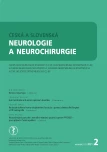Mechanical thrombectomy in stroke and the availability of the endovascular team during institutional emergency service – theory vs. reality
Authors:
D. Černík 1; L. Kmečová 2; F. Cihář 3; K. Bělinová 4; P. Janoušová 4
Authors‘ workplace:
Komplexní cerebrovaskulární centrum, Neurologické oddělení, Masarykova, nemocnice, Ústí nad Labem, Krajská, zdravotní, a. s., ČR
1; Detská klinika Slovenskej zdravotníckej, univerzity, Detská fakultná nemocnica, s poliklinikou Banská Bystrica, Slovensko
2; Radiologická klinika Fakulty, zdravotnických studií UJEP v Ústí, nad Labem a Krajské zdravotní, a. s., Masarykova nemocnice v Ústí nad, Labem, o. z., ČR
3; Komplexní cerebrovaskulární centrum, Emergency, Masarykova nemocnice, Ústí, nad Labem, Krajská zdravotní, a. s., ČR
4
Published in:
Cesk Slov Neurol N 2021; 84/117(2): 164-168
Category:
Original Paper
doi:
https://doi.org/10.48095/cccsnn2021164
Overview
Aim: Mechanical thrombectomy (MT) is the standard treatment for stroke due to the occlusion of a large endovascularly accessible artery. The topic discussed is the permanent presence of the endovascular team in a 24/7 mode in the center to reduce delays until the beginning of MT. Materials and methods: The set of 355 patients who underwent MT for large artery occlusion in the Comprehensive Stroke Center (CSC) in the years 2018–2019 was analyzed retrospectively. The data were confronted with theoretical assumptions according to the calendar share of working hours and the total annual time fund. Results: The period of institutional emergency service is approximately 76% of the time of the year according to the calendar data in the Czech Republic. This value was chosen as the most pessimistic value for the number of patients potentially admitted in the absence of the endovascular team (with a concomitant 100% admission of patients by primary transport to the CSC). 171 were treated in the CSC in 2018 and 184 in 2019. At the time of the institutional emergency service, 227 (63.9 %) patients were admitted. However, only 59 (16.6%) patients were admitted in the absence of the endovascular team at the time of the institutional emergency service. In the next steps, this number could be reduced to below 5%. Conclusion: Even with the impossibility of establishing the presence of an endovascular team in the center in a 24/7 mode, it is possible to reduce the number of patients admitted during the absence of the team to below 5%.
Keywords:
mechanical thrombectomy – stroke – endovascular team – day time
Sources
1. Sacks D, Baxter B Campbell BC et al. Multisociety consensus quality improvement revised consensus statement for endovascular therapy of acute ischemic stroke. AJNR Am J Neuroradiol 2018; 39(6): E61–E76. doi: 10.3174/ ajnr.A5638.
2. Darehed D, Blom M, Glader EL et al. Diurnal variations in the quality of stroke care in Sweden. Acta Neurol Scand 2019; 140(2): 123–130. doi: 10.1111/ ane.13112.
3. Bray BD, Cloud GC, James MA et al. Weekly variation in health-care quality by day and time of admission: a nationwide, registry-based, prospective cohort study of acute stroke care. Lancet 2016; 388(10040): 170–177. doi: 10.1016/ S0140-6736(16)30443-3.
4. Hoepner R, Weber R, Reimann G et al. Stroke admissionoutside daytime working hours delays mechanical thrombectomy and worsens short-term outcome. Int JStroke 2019; 14(5): 517–521. doi: 10.1177/ 1747493018790 079.
5. Šaňák D, Mikulík R, Tomek A et al. Doporučení pro mechanickou trombektomii akutního mozkového infarktu – verze 2019. Cesk Slov Neurol N 2019; 82/ 115(6): 700–705. doi: 10.14735/ amcsnn2019700.
6. Šaňák D, Neumann J, Tomek A et al. Doporučení pro rekanalizační léčbu akutního mozkového infarktu – verze 2016. Cesk Slov Neurol N 2016; 79/ 112(2): 231–234. doi: 10.14735/ amcsnn2016231.
7. Aronsson G, Theorell T, Grape T et al. A systematic review including meta-analysis of work environment and burnout symptoms. BMC Public Health 2017; 17(1): 264. doi: 10.1186/ s12889-017-4153-7.
8. Tsetis D, Uberoi R, Fanelli F et al. The provision of interventional radiology services in europe: CIRSE recommendations. Cardiovasc Intervent Radiol 2016; 39(4): 500–506. doi: 10.1007/ s00270-016-1299-0.
9. Václavík D, Bar M, Klečka L et al. Prehospital stroke scale (FAST PLUS Test) predicts patients with intracranial large vessel occlusion. Brain Behav 2018; 8(9): e01087. doi: 10.1002/ brb3.1087.
Labels
Paediatric neurology Neurosurgery NeurologyArticle was published in
Czech and Slovak Neurology and Neurosurgery

2021 Issue 2
- Metamizole vs. Tramadol in Postoperative Analgesia
- Memantine in Dementia Therapy – Current Findings and Possible Future Applications
- Memantine Eases Daily Life for Patients and Caregivers
- Metamizole at a Glance and in Practice – Effective Non-Opioid Analgesic for All Ages
- Advances in the Treatment of Myasthenia Gravis on the Horizon
Most read in this issue
- Morton’s neuralgia, metatarsalgia
- Moyamoya disease
- Correct and incorrect naming of pictures for the more demanding written Picture Naming and Immediate Recall test (door PICNIR)
- Etiopathogenesis and diagnostics of progressive multifocal leukoencephalopathy in patients treated with natalizumab
